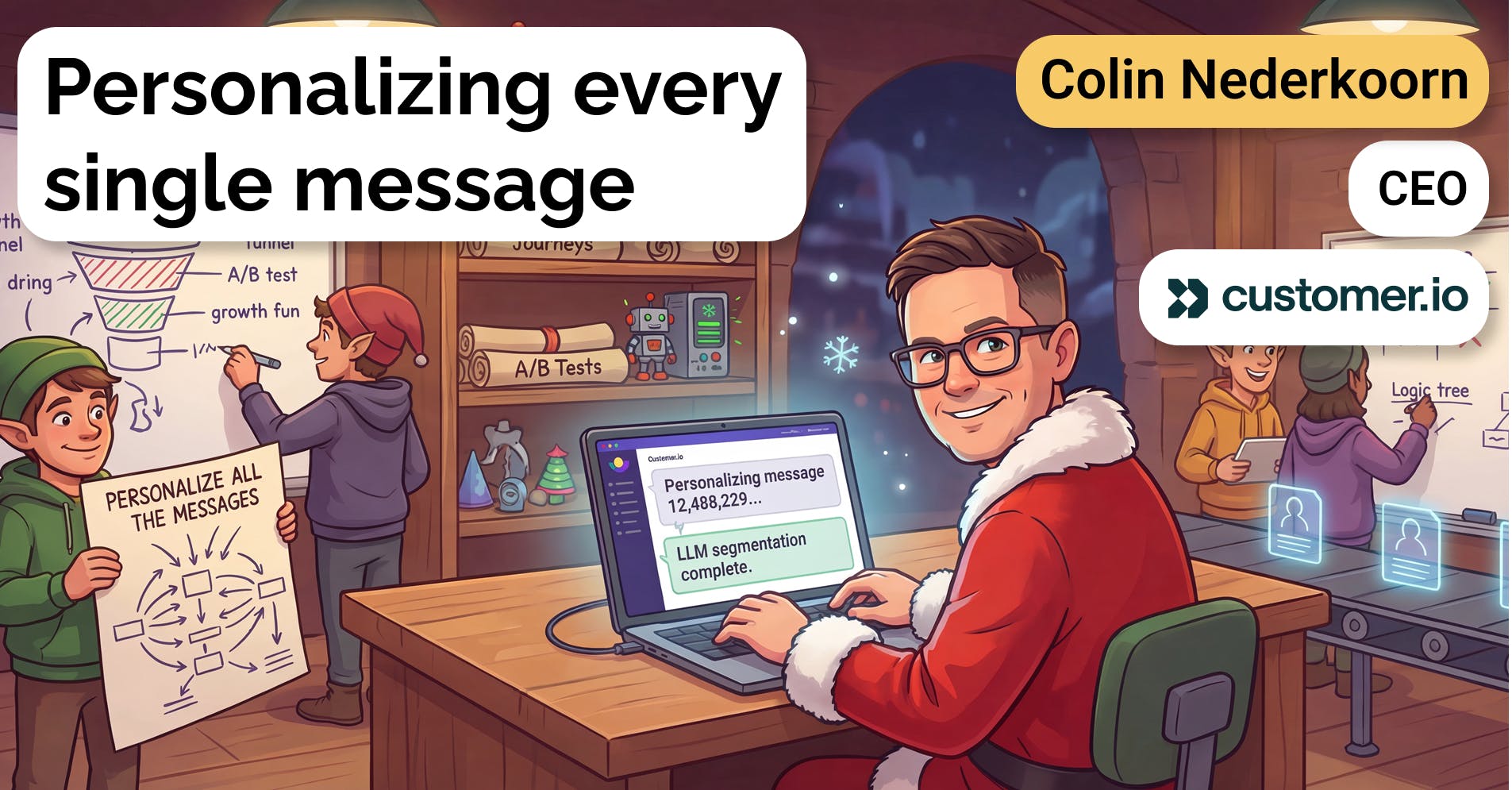Lenny Bogdonoff, co-founder and CTO of Milk Video, on the video infrastructure value chain
 Jan-Erik Asplund
Jan-Erik Asplund

Background
Lenny Bogdonoff is co-founder and CTO of Milk Video, a business video tool for quickly creating and sharing clips from live recordings like webinars. We talked to Lenny about where value is likely to accrue in the video infrastructure value chain, how he thinks about the landscape around video with companies like Adobe, Apple, Loom and Canva, and where the use of video in business is going.
Questions
- How do you see the history of business video, and why did you start Milk?
- I'm curious to learn more about what you're seeing as far as video use cases. Is it everyone in the organization making videos or just certain groups? How are they being shared? Is it one-to-one sales interactions, or one-to-many?
- It's more challenging to edit videos and turn them into a polished final project than it is text and images, which was part of why Canva and Instagram were successful. I'm interested to hear how you think about the difficulty aspect of this.
- It feels like what happened with images, where, starting with Instagram, you could edit the photo and get it ready for distribution as you're taking it, instead of it being split across these two different workflows.
- Canva has had a video product for a while, but they just launched a video suite. You mentioned that the use case is similar, almost more an editorial approach to content. I'd love to hear your thoughts on the Canva bundle and their opportunity in this space. Why do you think it might be easy or not easy for them to do this?
- What are your thoughts on the potential for some of the marketing and sales platforms -- HubSpot, Drift, Wistia, etc. -- to move backwards into the video creation stage?
- What’s your take on Apple and Adobe and their bundles and what their angle might be into the space? Do you see them as a competitive force in this kind of video creation specifically?
- Let’s talk about your infrastructure stack. What tools do you use, and what’s the value of each part of the stack to you relative to its cost? How do you think about outsourcing versus building yourself?
- You talked about the potential for Amazon Lambda to replace Mux for you and how video as a whole is changing and moving towards the browser. I’d love to understand better this potential disruption of Mux, Brightcove and similar companies. What are the mechanics that would make it possible for you to bring that in-house?
- Is there anything else that we didn't cover that you feel is important to talk about?
Interview
How do you see the history of business video, and why did you start Milk?
Let me start with why I started Milk and then it'll frame the rest of the questions here.
I have a film background. I went to a special film high school to study post-production animation editing, and essentially half of my classes in high school were just film programs. I thought I was going to go the Hollywood vocational route, but due to personal family things, that ended up not being the route I went.
Fifteen years later, I ended up spending about ten years of my career in software. During COVID, I was really surprised by how much content was being created, given the sheer video adoption to replace in-person activities, how the software that surrounded video production was still just film or social media-related and how no tooling had really formed around the newer applications of video in business.
If you think about business video, it's not that old. I mean, it goes back to the nineties and these old infrastructure companies -- even the term webinar is such an old term. But a mass consumerization of video in business is quite new. So I was very surprised that somebody who is good at their job in a marketing or sales or HR role would be now responsible for also editing video, and the only tools they had available were consumer-facing, like iMovie or even mobile tools, or extremely professional, like Final Cut, Premiere or DaVinci. Given how much I have seen software influence unstructured data -- machine learning, image recognition, just being able to transcribe audio -- the surprising experience I had was realizing that this hadn't taken any form in changing video editing software.
I started Milk last year in June because I felt like this was ridiculous. The consumer trend was that video was becoming the native form -- the first medium that you use to communicate -- and that had been taking place for quite a number of years. Then on the business side, all the people who were video-native young people would eventually become business world employees, and they would be very surprised that they don't have the tooling to express themselves in the ways that they're used to. And then all the people who are working in a remote-first world were hacking together the tools that were available to them.
Milk was meant to be a better video editing tool for businesses. From May to August or September, I was reaching out every single day to companies that were producing webinars -- because that was the thing that companies replaced their in-person sales activities with -- and I tried to figure out what they were doing with their video content after they created these assets. With an in-person event, you just have this one-and-done experience. With an online activity, you at least have an asset at the end.
I was very surprised how poorly that content was being distributed and how difficult it was to do anything with it after. Essentially, video files are these opaque, untouchable files that maybe you add something to in the beginning and end, like an intro and outro, or maybe you cut out some bits. But realistically, it was not something that anyone knew how to do -- it was more like there was a younger person who was more familiar who would do this kind of stuff. So that was the inspiration.
I also realized that manually editing videos for companies was unnecessarily repetitive and hard. What people are trying to do is pretty standard. The inputs are always these video recordings, Zoom content pieces. What they want to do is increase distribution, make it easy to find the important parts and send those to people in easily accessible ways, and also store and search the content that they already have to see what might be relevant.
Trend-wise, in the last two years, business video basically went from video being a thing that people did -- but were still using audio conference calls as their primary means of communicating -- to now you have this insane amount of new content being created by businesses for branding purposes, everything from fireside chats to webinars to educational content. It's all taking place in video, whereas before, it was text and at some level infographics, but primarily blog posts -- and podcasting, I think, is the same kind of longer-form engagement-based media.
Video is now what companies are expected to produce by default. Any company worth their weight, or at least going through a go-to-market motion, is going to start producing content very regularly. Of course they're going to create blog posts and maybe a podcast, but they're inevitably going to create a lot of video content. So that's where we emerged.
I'm curious to learn more about what you're seeing as far as video use cases. Is it everyone in the organization making videos or just certain groups? How are they being shared? Is it one-to-one sales interactions, or one-to-many?
We're primarily seeing people creating video content for social media to game the algorithms, so that they can stand out more in relation to all the other content that's out there. Essentially, if you put out a video that gets engaged with, then it just makes all the other content you put out perform better.
The marketing use cases that we have are specifically around content marketing. That's more like an ad, but in video form, so it's replacing a text or an image-based ad in a sense. The highest value type content that people are creating, or at least aspiring to create, is content where changing the medium from something else, whether it's text or image-based, to video ideally increases the conversion rate or engagement rate by some factor. So if a salesperson sends out a follow-up email to an event or a cold outbound email and they include video or a GIF plus a link to a video, then that's going to perform better than the text-only version.
To put it into a little bit more context, what we're seeing is that it's not so much whether you use video or don't use video, but the context in which the content is being created. So there are a lot more live experiences, like Zoom webinars, things like Clubhouse or Spaces, and even -- though much less in the business context, at least for the time being -- Twitch streams and whatnot. You see a lot more of this very high quality content that previously you would've needed a production team to produce, and now individuals are able to produce it on behalf of their companies.
What's interesting is that, previously, video used to be very high cost to produce, so the ROI that needed to be associated with it was also expected to be very high. You spent hundreds of thousands, if not millions, of dollars to produce a commercial or an educational video or series, and then your expectation was that that it would somehow lead directly back to sales. What we're now seeing is: because video can be created so easily in the live form, the recorded form, or the one-off form, there's much more of it created with lower expectations. So the iteration of using video to reach customers is happening much more.
And what's particularly interesting is that there's a kind of feedback loop: as tooling makes it easier, you create more video; as you create more video, you see more results; and as you see more results, the tooling gets better. I think that's the cycle that we're in right now.
It's more challenging to edit videos and turn them into a polished final project than it is text and images, which was part of why Canva and Instagram were successful. I'm interested to hear how you think about the difficulty aspect of this.
I'm a big fan of the ethos that you project out about fifteen years and then work your way backwards. So you can project out what happens if one thing gets super cheap or everyone starts doing it -- like the CMOS sensor, suddenly you have cameras everywhere, or bandwidth getting really fast or really accessible.
I think the trend that we're on right now is that live video -- not literally live streaming broadcast, but just being able to do things and capture it live and then have an asset as a result -- is the easiest way to create video content. It is far more preferable than the post-production editing process that requires a clear vision, and then a clear understanding of the tooling to achieve that vision. The reason that Loom is such a powerful tool is you just hit play, you do it, and then you're done. I think that process will be the way that any kind of video content gets produced in the future, but assisted with tools that make it much easier.
Specifically, when it comes to recorded content, because there are going to be forever video files that are created, whether consciously or unconsciously, I think there's a lot to be said for automated editing, which has yet to become really popular -- you saw glimpses of this around GoPros, where you would make a cool video really quickly from some action footage. Between GPT-3, image analysis APIs, and the kind of improvements around things like Gong or very vertical, specific AI video recording tools, I honestly think there's going to be a huge boom in automated editing software that businesses will use. You won't be editing and designing so much, but almost doing more of what Canva does, with editorializing what is important or applying a macro onto a video that creates some content that is brand appropriate, engaging and designed accordingly. I think that is the most interesting thing that has not really taken place yet in any kind of software.
Tools like Descript are a glimpse into what's possible, automating speech to text with word-by-word timestamps. I think that is just a small part of what becomes possible. If your goal is to create engaging content and you do a recording like this, you should be able to get six or seven premade shareable clips with a title on it and captions in six or seven different languages to share on different platforms instantly. Why not? They're all relatively straightforward steps that you have to go through, but there are only so many formats that you actually want to create, and that to me becomes the inevitable thing. Then the question is, what order do those things happen in?
The reason that we started our tool was because it felt like the process of editing things and the output was unnecessarily complicated. The immediate thing that people want is styled and captioned videos. It's very simple. Your Zoom video of a grid shouldn't be four people with one person picking their nose, but the one person that you actually care about, the line that they're actually talking about, and captions to make it engaging. The long-form content that no one's going to watch can become short-form content with the most important bits. All these things can be automated or at least assisted so that 90% of the work is done, and the person just cleans it up.
That doesn't exactly answer your question, but I think one very important trend is the fact that we're moving to live content production—editing it while you're making it. The other really big thing is moving over to automated editorial choices. We're trying to do that, but we have to do it piecemeal.
It feels like what happened with images, where, starting with Instagram, you could edit the photo and get it ready for distribution as you're taking it, instead of it being split across these two different workflows.
To go on a little tangent, I think something that is so important is that consumer trends are 100% leading anything business related. The reason that Instagram came to be is because we had mobile camera sensors everywhere. And the reason why business video is possible is because we have video cameras everywhere on our computers and everyone bought cameras over COVID. In the past, people didn't like being on camera, but now it's normalized.
Everything from blurred backgrounds to just presenting your slides -- that production process was just not normal. And now you have things that are like the equivalent of Twitch, where you have OBS interfaces. StreamYard and even Loom are implementing tools to make it easy to make things look cool or transition between stuff. Production suites used to require a lot of hardware, and now they’re just another tool that you use.
What's been really interesting for us to discover about business video is that consumers are really immature in terms of understanding what it is that they actually want. Consumer trends went from Instagram to Snapchat and from Snapchat to TikTok. At first just creating pictures and making them look good was good enough. Then after four or five years of posting weird pictures of you being drunk on a couch, ephemerality became much more popular. The social graph became much more expressive, and people wanted to consume the eventual TikTok-ification of feed-based, hyper-personalized, engaging content. I think we're going through that same trained series of cycles in business video, where people are producing way too much content, so they're now trying to create shorter content that's engaging.
Canva has had a video product for a while, but they just launched a video suite. You mentioned that the use case is similar, almost more an editorial approach to content. I'd love to hear your thoughts on the Canva bundle and their opportunity in this space. Why do you think it might be easy or not easy for them to do this?
My interpretation of Canva is it's very much one time use type creating content, which is essentially what the goal is. You want a medium to become so omnipresent that you don't think about what you're creating. I think that's why they're successful with small businesses, making flyers for personal stuff, etc.
I guess I don't know enough about Canva's video tooling adoption to say that they are doing “X” and they’re successful. My sense is, because Canva's general customer base is really individuals and small businesses, they're going to have a successful product one way or another, just because they have distribution on that side.
What we're leaning on is that the kinds of communication that businesses do, both between businesses and internally, require almost an operating system of what you do with video. It's a squishy term, but essentially, creating content, distributing it, measuring that result, and then being able to recall content -- an end-to-end process -- is the workflow that we're designing around.
The thing that I think is very interesting is to look at Microsoft Office in the nineties. Up to that point, the alternative to producing text documents was hiring a typist or somebody handling all of your word processing. Then the software got good enough, and everyone started typing their own stuff and producing their own content from the beginning. It wasn't like you had one word processor, it was that everything had word processing in it and was this WYSIWYG editor.
In my opinion, that is the trajectory of video. The ability to edit and manipulate and remix content is going to be the primitive that exists in any kind of content creation tool. The question becomes more vertically what you're trying to accomplish, and that results in differentiation. I wouldn't say Gong or something like Zoom is a competitor of ours. I genuinely don't think Canva is a competitor of ours. I think it's a very different category of content creation.
That being said, what we're trying to do is what you would do in Canva or Descript or a hosting tool -- all of those things you could do in our single tool. And we're trying to design very specifically for people who need to do very specific things: the salesperson who needs to create ads in multiple aspect ratios, the marketing person who needs to find the brand assets that they're going to use for the next creative they're creating, the person who's managing all the video files and searching for the right keywords. You can do that in our tool.
Video is the primitive that we're basing everything around, as opposed to images. That being said, I think images are going to be much more popular forever because it's just easier to hermetically transfer information in an image. But I do think the importance of video is only going to grow, in a different way. Just as I wouldn’t say text is competing with images, I wouldn’t say that images are competing with video.
What are your thoughts on the potential for some of the marketing and sales platforms -- HubSpot, Drift, Wistia, etc. -- to move backwards into the video creation stage?
The most interesting company acquisition in my mind was Clipchamp. They're an Australian based video editor that has been around for quite a while, and they got acquired by Microsoft. The reason that was so surprising was it totally fed into the narrative -- which I at least truly believe --that video is becoming a primitive that people use to express themselves in business.
Apple has iMovie, but Microsoft didn’t really have the tooling to do that. They have Movie Maker, but that really was around making movies. The idea is that you need templated video creation tools that will let you cut, trim, rearrange or organize video, and that’s essentially a primitive for communication that any company will need.
If everyone does that, then the question becomes, what are the things that really differentiate? I think the things that are very interesting and that didn't exist as cheaply before are transcription -- the fact that you have a very omnipresent ability to search unstructured video -- and then image processing based on video -- being able to analyze time series data. What transcript data let us do is speaker identification. You can summarize content, do time ranges of topics, stuff like that. The time series data around video is interesting because you can automate the process of creating well produced content quite easily if you have someone presenting something that is supposed to fit into a specific kind of template. If you have two people speaking, you can highlight the video of the person speaking in some way. At the post-production level, to be able to create content like that easily is quite interesting.
Companies like HubSpot or Salesforce creating their own video creation tools? I think that's inevitable. They will buy their own content producing companies or make them internally. The thing that's interesting is that editing video is something that people traditionally won't want to pay for. Something like Canva is provides so much functionality, but the things that people actually want to pay for are quite specific.
Companies like Milk can get sidelined or subverted by a big company providing that service for free. So the question becomes: what are the things that companies that specialize in video-related production can do to become differentiated in some way? I think that’s more along the lines of storage, search, things like handling brand consistency, being a place where people actually measure the impact of content. So not just creating a video, but storing a video, sharing out links and embeds, making video into a landing page -- that kind of stuff starts to become more important because the creation and editing part becomes commodified at some level.
What’s your take on Apple and Adobe and their bundles and what their angle might be into the space? Do you see them as a competitive force in this kind of video creation specifically?
I think Adobe is a slowly dying company. Most of their revenue comes from ad-based stuff, marketing and all this data. They're basically a glorified consulting company at this point, and their market cap reflects that. They are trying to do things in the realm of single-purpose, one-off, machine learning-based integration tools, and they can acquire their way to competition, but I don't think they're going to build anything in this space that becomes useful. It will just be three or four years late every single time. And Apple – that’s like saying that Windows or something hardware-wise is going to create some stuff.
To reemphasize, I think editing is the commodity. What’s interesting is where the video content comes from that goes into the production process. Livestream-based platforms like Riverside or StreamYard, which was growing very quickly before Hopin bought them, are very interesting. The fact that you have this ability to record and share content asynchronously -- things like Loom -- I think that will become ever present. Tools like Descript -- you can just throw in a screen recorder where people create content very easily. I’m sure that will become omnipresent in tools that exist already, so Adobe will do their own version and Apple will do their own screen recorder or something like that.
The fact that content is searchable is also really big. For a company, the thing that becomes important is the system of record. So you have companies like Rewatch raising huge funding rounds. They have just a couple customers, but really reputable names. It becomes important to create a system of record that preserves security and that lets teams manage how content is aggregated or discussed. I am kind of surprised that Google hasn't produced more kind of content around this. I was also surprised that Dropbox never went into the multimedia world, given that their whole business is around bandwidth and storage.
I'm excited for any medium that increases somebody's ability to communicate bandwidth-wise. How many ideas can you convey in a short period of time? It’s not really a tangible metric. In text, you're dependent on the reader's reading speed to communicate, so you're limited by the receiving bandwidth side. You can have a fiber internet connection, but the other person has 26k -- you're screwed. And that can be reflected not just in their reading speed, but they could be tired or distracted, that kind of stuff. Audio -- you have at some level the opportunity to reach them, but are they paying attention to what they're listening to? It’s the difference between elevator music versus a podcast. And then video -- if someone has an understanding of what they are watching and how long it is, they can commit if they're going to actually pay attention or not. The bandwidth opportunity there to communicate ideas in a period of time is very high.
We went from, when film was first made, people just recording in-person play, to people creating Saw --something that scares the hell out of somebody because of the editing techniques. I think we're going through that transition with live video production in the tooling that will help people do that more easily. It has yet to really mature. I think big companies will actually standardize that kind of stuff much more.
Let’s talk about your infrastructure stack. What tools do you use, and what’s the value of each part of the stack to you relative to its cost? How do you think about outsourcing versus building yourself?
We run our servers in AWS. Our video coding happens in Mux. We use a transcription tool called AssemblyAI, which I think is the best cost and quality transcription. We run a Rails app as our backend and a React app as our frontend. Technical details aside, what that means is we're using a lot of different services and we're hosted on a number of different places.
I think the most interesting infrastructure thing is the importance of Amazon's Lambda functions and that has become such an important component of our tech stack. Not because creating software that runs single functions is interesting, but because it's just really fast. Amazon introduced Lambda layers about two years ago. They let you share executable code across different functions. For example, you can use something like FFmpeg, which is the standard for video transcoding, muxing, manipulation, binary. Rather than having to load a piece of software that will then run a piece of software, you can have very small bits of code that share encoding software. Because of Amazon Lambda, we'll probably replace Mux in the near term, in piecemeal. Lambda will be able to replace a lot of external dependencies that do image reprocessing, resizing, that kind of stuff.
The thing that we will not be able to replace, just because we don't want to manage it ourselves, is this stuff around transcription, at least for the next four or five years. Transcription software has gotten so good. The research has gotten so good. There are off-the-shelf, offline transcription models that you can download and start using for free.
If you need to transcribe live this speech that we're creating right now, you can get quite well-transcribed text in English. The thing is there's a lot of layers of stuff on top of that, which then become not worth managing. How do you treat numbers? Where do you punctuate? How do you handle pronouns? Stuff like that. It's worth just paying somebody to do that. On the video side, paying Mux $3 or $4 an hour does not make any sense when you can do the same thing for 70 or 80 cents at a time. That premium is a little bit too high.
Our core competency is around design UX patterns. Being able to build quickly is actually probably the real core competency. People like Canva, Descript, who establish good patterns -- those are the things that we want to be able to implement very quickly for our use cases. Right now we're much less worried about cost, in terms of infrastructure, because our margins are so high. Our customers are paying us $15 grand a year to create a couple clips of video. That's huge because we're operating more in a solution ecosystem as opposed to per-hour, per-video creation. We're baking in somebody being able to create hundreds of hours of content or upload hundreds of thousands of hours of content, if they want to.
The things that are more interesting, in terms of infrastructure, are how we can become the fastest tool -- things that are relatively new in the video production space. We went through a trend where a lot of the software was literally software, something you'd download and run on your computer. You have the iMovie, Final Cut, Premiere world. If you wanted to encode different files or different sizes, you would do that on your computer, and then you would send that to somebody.
Then we went to the other extreme, which is software on the server handling all your video manipulation -- this is your Brightcove, Mux and the like. Any muxing and any kind of changing the format of a video would all happen on the server.
Now the browser has gotten so powerful that anything like Loom or any of the APIs that the browser has gives new flexibility to create stuff on a computer without needing to be deeply invested in understanding video. In the past making highly complex video required deep video knowledge, but now anyone can add a Loom integration or Loom functionality because Chrome lets you do that easily.
What's interesting is the shuttling between what should be done on the client and what can be done on the server, and then creating software that is in the browser but takes advantage of someone's computer and also of the server where needed. That is what we're trying to accomplish.
Our video creation process is very non-traditional. Most people are using C libraries to compile a video and cut up video content. But we do everything browser-based even to the point where we generate a video frame by frame in browser sessions, screenshot them, turn them into images and then compile all those images and turn those into video. We do that because it lets users express things very easily. The cost is much higher than if you did something at the hardware level or in some C binary form, but it lets us move very quickly. We can create very expressive video content faster than somebody else would, and anybody working on our team can create new video tools as a result.
I think the most interesting companies in this space right now are like Descript, just because they have such a head start. When I talked about machine learning stuff, one thing I didn't mention is the deep fake stuff. Being able to generate audio and video content, that's a whole other category, which is absolutely fascinating.
Then you have other companies like Runway ML, which I think are still much more for the consumer phase of the machine learning ecosystem -- video-based editing tools that green screen out moving objects or do background removal, but for more artsy things. I think that will have a business impact in the future. We just aren't there quite yet. Maybe in three or four years from now.
And also the generative artificial speakers, being able to record yourself saying 90% of something and then replace yourself saying something else just at the beginning. That will all be on server-based infrastructure. That has the different implications -- speaking different languages, being able to talk about different topics, and just edit it with text.
You talked about the potential for Amazon Lambda to replace Mux for you and how video as a whole is changing and moving towards the browser. I’d love to understand better this potential disruption of Mux, Brightcove and similar companies. What are the mechanics that would make it possible for you to bring that in-house?
I think Mux’s big money maker is the data tool that they have, being able to measure and monitor video performance at scale for streaming companies. It’s easier to outsource the quality control because that's Mux’s specialty and the other companies are content companies. That's not going to change.
If you think about video becoming a primitive for expression, there's a lot of things that right now you're outsourcing to video services -- whether it's streaming, transcoding, editing, layering on things like captions, stuff like that -- that previously were built out in pieces of software, like an Adobe tool or something. But I suspect the APIs around how you interact with video will just keep getting better to the point where it's just easier and easier to create video content much more easily. By default, when you create video content, you won’t have to worry about transcoding into different sizes. Some very simple things are way harder than they need to be right now, given how we use the internet, and I think that stuff will slowly get replaced.
A specific example, in terms of Mux, is when you create a video file and want to share it online. You need to transcode it into a format that can then stream the files in smaller bits, and you need an infrastructure that will do that to the video file. Because there are maybe six or seven different things that you have to do, it’s hard to get a video file and share it with somebody. It's easier to pay somebody who just thinks about that kind of stuff. But I think the steps involved will start to become encompassed into one single step. The browser-based APIs will become smarter, and instead of having to pay for a specific tool, hosting providers will provide it by default.
Very specifically, we're using Lambda instead of Mux because it’s just so much cheaper to run a Lambda function for ten seconds to get the same output that we would pay Mux for. We can run FFmpeg on an hour-long video and run that process in six seconds, which costs us cents, and then upload that to S3. There's just a function that we can plug in very easily, and we can even share that with someone else so that they can use it very easily. The three or four hours to set that up is much better than paying Mux luxury video hosting prices into perpetuity.
Is there anything else that we didn't cover that you feel is important to talk about?
One thing that's interesting about the business models for some of these companies, pricing-wise and distribution-wise, fall into two categories, at least that I've seen.
On the video tooling side, there's the distribution strategy, which is discovery based on jobs that need to get done and really depending on SEO to create utility-based video tooling. Then on the other side, you have direct outbound sales, with almost ambiguous actual final utility, but general solution-oriented things. For instance, these video event companies charge a lot of money, but what you're actually getting versus what the utility is is a bit ambiguous.
The utility-based video tools are always going to exist -- the tool that will cut your video, trim the beginning or let you add subtitles -- but I think those businesses have a very clear upper bound limit. But the tools that can do this direct outbound sales motion -- those are the ones that are going to be huge, because they can target companies that are now investing more money into their video strategies. That repeatable process, such as booking meetings or getting deals with people who are producing a video, is going to be a big business. I'm very bullish on that.
On billing per seat versus per utility versus service provided time periods, there's only so much you can do, I think. Video creation relative to say, Figma, is not a multiplayer activity right now. It's very much up production, where editing is just one step in the production process. I don't think you'll see a big Figma for video-type company in the next five years or so. Maybe in ten years you might, but in the next five years, it won't be the killer feature for video.
What you will probably see as a killer feature, I believe, is video content being used to drive correlation between ROI and sales. Wistia version two -- a version of Wistia that integrates highly with Salesforce or helps that kind of stuff, whereas Wistia currently makes its money because of infrastructure. I think that has a really big opportunity, because then you can actually attribute the impact of some of this multimedia that is otherwise ambiguous.
Look at Gong, which is a tool that transcribes video calls so that they can be reviewed by a team: your best performing salesperson can influence the worst performing salesperson, and the manager has some level of awareness of what's going on. That kind of granularity has just not been possible up to now, but it’s becoming more and more possible. The creation tools that integrate more on that end will do much better than tools that are just single-purpose utility-type tools.
Disclaimers
This transcript is for information purposes only and does not constitute advice of any type or trade recommendation and should not form the basis of any investment decision. Sacra accepts no liability for the transcript or for any errors, omissions or inaccuracies in respect of it. The views of the experts expressed in the transcript are those of the experts and they are not endorsed by, nor do they represent the opinion of Sacra. Sacra reserves all copyright, intellectual property rights in the transcript. Any modification, copying, displaying, distributing, transmitting, publishing, licensing, creating derivative works from, or selling any transcript is strictly prohibited.









